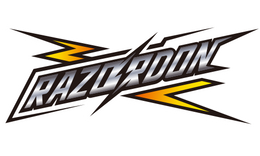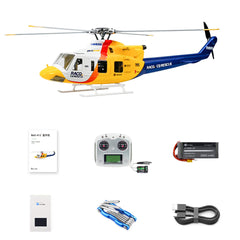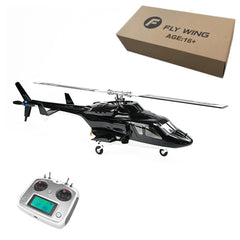Have you ever dreamed of piloting a helicopter that looks and flies like the real thing? Scale
RC helicopters bring that thrill to life with stunning detail and precision. Unlike toy-grade helicopters,
Scale RC models replicate the appearance—and in some cases, even the mechanics—of real-life helicopters, down to their paint schemes, fuselage design, and landing gear.
From understanding sizing systems to choosing the perfect model, building, flying, and maintaining your helicopter. This ultimate guide to scale RC helicopters covers everything you need to know.
What Are Scale RC Helicopters?
Scale RC helicopters are remote-controlled models designed to replicate the appearance—and often the flight characteristics—of real helicopters. Unlike standard RC helicopters built for speed or aerobatics, scale models prioritize realism.
The Meaning of “Scale” in RC Helicopters
The term "scale" refers to the precise proportional reduction of a real helicopter's dimensions. Common ratios include:
- 1:34 scale: Compact models like the WOLFBUSH AW-911 Airwolf RC Helicopter (ideal for beginners)
- 1:12 scale: Mid-sized replicas such as the Align T-Rex 600E Apache
- 1:8 scale: Giant-scale models like the Vario Bell 222 with functional retractable landing gear

Key Features That Set Scale Models Apart
- Realistic Design: Detailed fuselages, accurate paint schemes, and functional features like retractable landing gear.
- Complex Mechanics: Advanced rotor systems and gyroscopes for lifelike flight.
- Customization Options: Hobbyists can add decals, lights, or even sound modules for enhanced realism. These features make scale RC helicopters a favorite among both collectors and pilots.
Who Should Consider a Scale RC Helicopter?
- Scale RC helicopters suit a wide range of hobbyists:
- Beginners: Start with user-friendly, ready-to-fly (RTF) models to learn the basics. For indoor flying or limited space, mini rc helicopters are an ideal entry point—lightweight, safe, and affordable.
- Enthusiasts: Advanced pilots enjoy building and customizing kits for a hands-on experience.
- Collectors: Those passionate about aviation history love scale models for their aesthetic appeal. Whether you’re drawn to engineering, the flight experience, or the visual artistry, scale RC helicopters offer something for everyone.

RC Helicopter Sizing Systems Explained
Understanding the sizing systems for scale RC helicopters is key to choosing the right model. In the hobby world, two systems are commonly used. Let’s break them down.
Class-Based Sizing
In RC terminology, “class” refers to the size category of a helicopter, usually based on the length of the main rotor blade or the distance from the main to the tail rotor shaft.
Common Classes:
| Class |
Rotor Blade Length |
Use Case |
| 250 |
~230 mm |
Indoor, beginner sport models |
| 450 |
~325–360 mm |
Entry-level scale + sport use |
| 500 |
~425 mm |
Stable, mid-size outdoor flights |
| 600 |
~550–600 mm |
Realistic performance, longer flight time |
| 700 |
~690–720 mm |
Professional-grade, ideal for detailed scale fuselages |
These classes are most relevant when purchasing flight-ready frames or kits. For example, the popular Flywing FW450L Airwolf is a 450-class model that can be paired with a scale Airwolf fuselage for stunning visual realism.
Scale Ratios
A scale ratio expresses how much smaller the RC model is compared to the full-size helicopter. For example:
- 1:32 scale = 1 unit on the model equals 32 units on the real aircraft
- 1:6 scale = the model is one-sixth the size of the real aircraft
Scale ratios are typically used to describe fuselage shells or static display models, but many flying models also adopt this terminology when showcasing realism. The higher the scale (e.g., 1:4 or 1:6), the larger and more realistic the model tends to be.
Class vs. Scale: What’s the Difference and Why It Matters
This is one of the most common areas of confusion, especially for beginners.
| Concept |
Class (e.g., 450L) |
Scale (e.g., 1:32) |
| Measures |
Rotor blade / frame size |
Proportional size to real helicopter |
| Purpose |
Categorizing flight capability |
Describing realism and appearance |
| Application |
Used for selecting airframes |
Used for choosing fuselages or comparing visual scale |
| Example |
Flywing FW450L is a 450-class helicopter |
Roban UH-60 1:6 scale fits a 700-class frame |
Many new pilots think that “450” means 1:4.5 scale—but that's incorrect. A 450-class helicopter might only be 65–70 cm long, which could represent a 1:25 to 1:30 scale, depending on the full-size counterpart.
Tip: If you're buying a scale fuselage, always check which class-size frame it fits (e.g., “Fits 500-class frames”).
Popular RC Helicopter Classes and Recommended Models
Now that you understand the difference between class sizes and scale ratios, let’s explore the most popular RC helicopter classes for realistic flying—and the recommended models in each. These sizes offer the best balance of performance, customization potential, and visual realism.
Summary Table: RC Helicopter Classes and Models
| Class |
Rotor Span |
Flight Role |
Recommended Model |
| 450L |
~720mm |
Beginner to Intermediate |
Flywing FW450L Airwolf |
| 470L |
~760mm |
Intermediate |
FLYWING Bell-412 GPS |
| 500L |
~850mm+ |
Advanced/Scale Enthusiast |
FLISHRC FL500 AH-1 HueyCobra |
450 Class – Compact and Capable for Beginners
The 450 class is one of the most accessible sizes in the scale RC helicopter world. It offers a great entry point for hobbyists who want a manageable size without compromising on scale realism.
- GPS-assisted flight with Return to Home (RTH)
- Supports auto-hover and 3D flight modes
- Comes with a scale-style Airwolf fuselage
- Easy to transport and maintain
Ideal for: Beginner to intermediate flyers looking for a realistic 450-class RC helicopter with high stability and impressive visuals.

470L Class – Mid-Sized Military Style With Professional GPS Stability
The 470L-class Bell-412 is a standout for fans of military-scale helicopters. Modeled after the real twin-engine utility helicopter, this version offers both visual fidelity and autonomous flight features, making it perfect for controlled outdoor flying.
If you're exploring
GPS RC helicopters with advanced stability and flight automation, models like the Bell-412 are a great starting point.
According to our size classification breakdown, 470L helicopters offer greater visual presence in the air while still being manageable for hobbyists upgrading from 450L frames. The added body volume allows for more detailed fuselages and more stable performance in the wind.
Key Features:
- Realistic Bell-412 scale fuselage
- Precise GPS stabilization with waypoint function
- Functional navigation lights and detailed paintwork
- Excellent mid-level platform for immersive scale flying

500L Class – Large-Scale Flying With Full Visual Impact
This 500L-class model replicates the Bell AH-1 HueyCobra, complete with detailed military paint, realistic cockpit, and long tail boom. As your flying skill progresses, upgrading to a 500L helicopter brings you into a more immersive and stable scale experience.
Unlike smaller models, 500L helicopters offer enough space and frame strength to accommodate functioning retractable landing gear, custom lighting systems, and modular scale upgrades.
Key Features:
- Full-scale AH-1 HueyCobra military design
- Strong outdoor stability with long rotor span
- Larger battery compartment for extended flight time
- Suitable for experienced users seeking realistic handling
Power Systems for Scale RC Helicopters
Scale RC helicopters use different power systems, each with unique benefits. Here’s a quick comparison.
Electric vs. Nitro vs. Turbine
| Type |
Pros |
Cons |
Best For |
| Electric |
Quiet, low maintenance |
Limited flight time (~8-12 min) |
Beginners, urban areas |
| Nitro |
Longer flights, realistic sound |
Messy, requires tuning |
Intermediate users |
| Turbine |
Extreme realism, jet engine roar |
Expensive ($5K+), complex |
Expert collectors |
Pro Tip: For longer electric flights, recommend high-capacity LiPo packs (e.g., 5000mAh 6S)
How to Choose the Right Scale RC Helicopter for You
Selecting the perfect scale RC helicopter requires balancing skill level, flying space, budget, and desired realism. Here’s a step-by-step guide to finding your ideal model.
Match the Helicopter to Your Skill Level
Your current experience with RC aircraft should be the first filter when choosing a scale model. Larger, heavier, and more powerful helicopters offer stunning visuals and control precision—but they also demand more skill to operate safely.
| Skill Level |
Recommended Class |
Suggested Power |
| Absolute beginner |
450L class |
Electric (GPS preferred) |
| Intermediate flyer |
470–500L |
Electric or Nitro |
| Advanced hobbyist |
600–700L |
Nitro or Turbine |
Choose the Right Size for Your Flying Space (Indoor/Outdoor)
Scale RC helicopters vary dramatically in physical footprint and require airspace. Choosing the wrong size for your environment can quickly lead to crashes or frustration.
| Size Class |
Minimum Flying Area |
Best Locations |
| 450-class |
30x30 ft backyard |
Parks, small fields |
| 550-class |
Soccer field (100x150 ft) |
Large open areas |
| 700-class |
200x200 ft+ |
RC airfields, rural spaces |
Safety Tip: Larger helicopters (550+) can cause serious injury—always fly in designated areas.
RTF vs. Kit vs. ARF – Which Is Right for You?
Understanding the build format of your helicopter can save you time and frustration. Here's a breakdown:
| Format |
What It Means |
Pros |
Cons |
| RTF (Ready-to-Fly) |
Comes pre-assembled and ready for immediate flight |
Fast setup, beginner-friendly |
Limited customization |
| Kit |
Requires full assembly from parts, including electronics |
Maximum customization |
High learning curve |
| ARF (Almost Ready-to-Fly) |
Assembled airframe only; you add electronics |
Balance between DIY and speed |
Still requires some knowledge |
If you’re just getting started or want a scale RC helicopter with minimal setup, choose an RTF scale RC helicopter kit. These typically include a transmitter, receiver, and pre-tuned flight controller out of the box.
Budgeting for a Scale RC Helicopter Setup
| Budget Range |
What You Can Expect |
| Under $300 |
Entry-level 450L electric RTF scale helicopters with GPS, basic scale fuselages |
| $300–$800 |
Larger models (470L–500L), more detailed scale shells, better flight controllers |
| $800+ |
600–700 class airframes, military replicas, turbine-ready models, retractable gear systems |
Pro Tip: Don’t forget to budget for batteries, a charger, spare parts, and possibly a radio transmitter—especially if you choose a Kit or ARF version.

Flying Tips for Scale RC Helicopters
Flying scale RC helicopters requires practice and precision to achieve realistic flight. Here are essential tips.
Pre-Flight Checklist for Scale Models
Before every flight:
- Check rotor blades for damage.
- Ensure batteries are charged and secure.
- Verify radio connections and gyro settings.
- Inspect the fuselage for loose parts. A thorough check prevents crashes and prolongs your model’s life.
Hovering and Smooth Maneuvers for Realistic Flight
Start with hovering to master control. Practice smooth transitions for forward flight and gentle turns to mimic real helicopters. Use a simulator like RealFlight ($100) to build skills without risking crashes.
Beginner Mistakes to Avoid
- Overcorrecting: Small inputs are key; avoid jerky movements.
- Ignoring Wind: Fly in calm conditions to prevent instability.
- Skipping Maintenance: Regular checks prevent costly repairs. Patience and practice are crucial for success.
Flight Conditions and Weather Considerations
Fly in winds below 10 mph for most models, and avoid rain or extreme heat, which can damage electronics. Larger models (e.g., 700-class) handle wind better but require more skill.
Maintenance and Longevity
Proper maintenance ensures your scale RC helicopter stays in top shape for years.
Why Maintenance Matters for Scale RC Helicopters
Regular care prevents wear, improves performance, and protects your investment. Scale models, with their detailed fuselages, are especially prone to damage if neglected.
- Cleaning: Wipe down the fuselage with a soft cloth and remove dust from rotors.
- Storage: Keep in a dry, dust-free case away from direct sunlight.
- Battery Care: Store LiPo batteries at 40% charge and avoid over-discharging. Check manufacturer guidelines for specific care instructions.
How Often Should You Inspect Your RC Heli?
Inspect before and after each flight for loose screws, worn blades, or motor issues. Perform a deep inspection (e.g., checking gears and electronics) every 10-15 flights or monthly.
Final Thoughts: Why Scale RC Helicopters Offer the Ultimate Flying Experience
Scale RC helicopters masterfully blend cutting-edge flight performance with breathtaking realism, creating an unparalleled hobby experience. Whether you want to fly or simply admire, the world of scale RC helicopters delivers unmatched satisfaction, with every takeoff and landing.
Ready to find your perfect model? Explore top-rated scale RC helicopters and accessories at Razordon today.
You Might Also Like:












